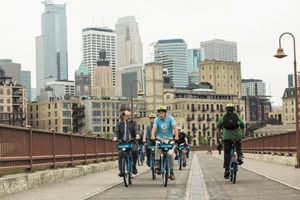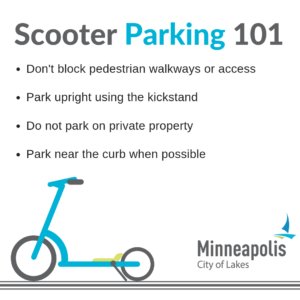Nice Ride/Lyft now offers two types of bicycles, scooters and Ebikes in rapidly shifting market
 Luci Daum Design Dresses, Minneapolis, Minnesota, July 22, 2018.
Luci Daum Design Dresses, Minneapolis, Minnesota, July 22, 2018.By TESHA M. CHRISTENSEN
Nice Ride planned to offer 3,000 Ebikes this summer in Minneapolis, but in such a rapidly changing market they weren’t able to deliver.
It’s both frustrating and exciting for Nice Ride’s Bill Dossett, who has been along for the ride since former Mayor R.T. Rybak first suggested Minneapolis needed a shared bicycle system and he should get involved.
Nice Ride partnered with Motivate (now owned by Lyft) in July 2018 with the understanding that it would provide 3,000 new dockless bikes for 2019. They provided 1,500 regular pedal bikes and then proposed an alternative for the rest: pedal-assist Ebikes. The agreement was then modified for 1,800 Ebikes instead.
However, Lyft has had trouble fulfilling that order. There have been three versions of its Ebike this year, pointed out Dossett. Lyft recalled most of its second version fleet in April due to faulty front brakes. The third, The Watson, is in development and receiving major upgrades.
Minneapolis is one of the only cities in the country to have the Watson – and there are only 50 here.
They will be part of demonstrations at various events, including Open Streets, but won’t be available for rent until next spring when the full shipment of Ebikes is expected.
“My frustration is we don’t have the Ebikes,” acknowledged Dossett.
But he’s excited by the possibilities for how Ebikes will shift the shared mobility marketplace, and offer users more options.
 Twists and turns
Twists and turns
Dossett has been part of the shared mobility journey in Minneapolis since 2008 when you couldn’t ride a bike down Nicollet Mall.
He was among a group of local active-living advocates led by the Loppet Foundation and supported by the city of Minneapolis Community Planning and Economic Development Department that launched Nice Ride in 2010. While bike share has been around for about 40 years, they were inspired by the subscription program Paris implemented in 2007.
They operated 65 stations with 700 bikes in that first season. Nice Ride grew to 200 stations with 1,850 bikes in 2017. (More at managesharedmobility.org)
“There have been a million twists and turns,” said Dossett.
The first bikes were funded by $2 million in federal funds and $1 million from Blue Cross. They knew from the start that they wouldn’t earn enough in subscription fees to cover all the costs, so they solicitied about $200,000 a year in station sponsorships from companies such as Target, Seward Co-op and Peace Coffee.
They were driven by experimentation. They tried out pilot projects in Greater Minnesota including Bemidji and Rochester. And in the middle of it, apps happened.
The biggest challenge arose two years ago: dockless systems and much cheaper bicycles came on the scene. Bikes been selling for $1,100 and were now only $40 because they didn’t need as much technology. They had shifted from a smart bike to a smart dock, pointed out Dossett. China led the way, and saw bike share numbers jump from zero to 25 million in less than two years.
 Nice Ride made the decision to get away from operation (although it still holds the official license agreement with the city through August 2021), and hire another firm to do that piece. They selected Motivate International, the largest operator of bike sharing in North America, to operate the green bikes and deliver a dockless (blue) bike pilot. Nice Ride’s board and only staff member Bill Dossett then entered a new role as mobility manager, serving as the bridge between public sector goals and private investment. Their goals are order in the right of way, quality and reliability, and equity, said Dossett.
Nice Ride made the decision to get away from operation (although it still holds the official license agreement with the city through August 2021), and hire another firm to do that piece. They selected Motivate International, the largest operator of bike sharing in North America, to operate the green bikes and deliver a dockless (blue) bike pilot. Nice Ride’s board and only staff member Bill Dossett then entered a new role as mobility manager, serving as the bridge between public sector goals and private investment. Their goals are order in the right of way, quality and reliability, and equity, said Dossett.
“We knew that the technology was going to continue to evolve,” observed Dossett, so they sought to structure their contract with Motivate in a way that allowed for that. “We didn’t think it would change this much.”
How do you grow bike share use?
The question Nice Ride posed was: “How can we get a lot more people to use bike share for transportation?”
A typical user will only bike to work for a certain distance and after that they think it is too far or they worry about arriving sweaty. The Ebikes solve that problem by helping a rider get farther. Dossett hopes that Ebikes will be used by people in the suburbs to transport themselves the 20 miles into the city, or by those in smaller cities to travel within those areas.
He clarified that the Nice Ride offers pedal-assist Ebikes. They work effortlessly, engaging based on how hard the rider is pedaling, and can mean the rider doesn’t necessarily know when its working. Instead, they feel like “Wow! I have Superman legs,” observed Dossett.
The assist stops after a rider has reached 18 miles per hour. they can go faster on the bike – but only with their own power. The Ebikes do not have a throttle like scooters.
Dockless pedal bikes
One of the next steps is to work out the kinks in storage and return of the dockless bikes and scooters.
As Nice Ride was planning how to implement its dockless system, they were driven by an idea. “Our goal was to be the one city in the world that came up with a rational way to manage right-of-way,” stated Dossett.
“It hasn’t worked perfectly.”
Contributing to the issue is that the expectations for scooters and bikes are different. With a scooter, you can leave it at your destination. The bike is expected to be left at the virtual station that the rider finds on the app.
When blue bikes are left at other locations, they can usually be found – but not always. If the batteries run all the way down the GPS no longer works. Other times, the 2G network fails.
So, if you see a bike or scooter where you don’t think it belongs, check for the number on the device and call it or 311. (Please note that there are several companies in the Twin Cities that offer scooters, not just Nice Ride/Lyft).
Rainy weather delayed the the installation of hubs this summer, and the system didn’t reach 250 hubs until July.
Nice Ride has been happy with the quality of the bikes and Lyft’s team of in-shop and on-street mechanics who are maintaining each fleet at a level higher than the nonprofit was able to achieve in prior years.
Moving forward, Nice Ride is working to make things simpler for riders.
“If we want increased participation in bike sharing, we have to make it simple to find a bike and end a trip,” observed Dossett in an Aug. 19 memo. “If we want to enforce parking requirements with penalties, compliance must be easy and intuitive.”
The Scooter Experience
Scooters have come on the scene fast, and Dossett thinks they are here to stay.
“This is a way to get people out of cars and using more sustainable transportation.”
He added, “This is what consumers want, and we need to figure out how to get there.”
That leaves policy makers and businesses to figure out what the rules will be for this new type of shared mobility, particularly as it relates to scooters left lying on sidewalks and blocking right-of-way. Our Streets, the city’s Bicycle Advisory Commitee and others will really start to ask those questions this fall and gather input from residents, according to Dossett.
Right now, JUMP, Lyft, Spin, and Lime are operating about 2,000 scooters in Minneapolis, governed by contracts with the city.
Companies are required to collect scooters starting at 10 p.m. The scooters may be re-deployed beginning at 5 a.m. the following day.
From August to November of 2018, the city of Minneapolis permitted a scooter pilot with up to 400 scooters available for shared use throughout Minneapolis. Almost 75,000 people took over 225,000 trips during the 4-month pilot period.
Minnesota Statute 169.225 (passed in 2018) outlines where motorized foot scooters can operate:
• Must follow the same traffic laws as bicyclists
• Cannot be ridden on the sidewalk
• Can be ridden in bike lanes, paths, and trails unless signs prohibit
• Ride as close as is practicable to the right-hand side of the road
“Scooters help make the case for why we need more and better bike lanes,” observed Dossett.
Shared mobility to keep
growing
Last year, there were 70 different companies with new capital working on shared mobility options, including Ford.
Dossett predicts that over the next few years, cities will increasingly design streets, sidewalks, and boulevards to createspace for shared micromobility parking, and will likely require that shared vehicles be parked in those spaces, particularly in downtowns.
Micro mobility and shared mobility options are only going to continue to grow and develop, believes Dossett. He foresees more electric cars and smaller cars coming onto the scene.
“You’re going to see a lot of experimentation,” he said.
~ Contact editor at tesha@longfellownokomismessenger.com
Comments
No comments on this item Please log in to comment by clicking here